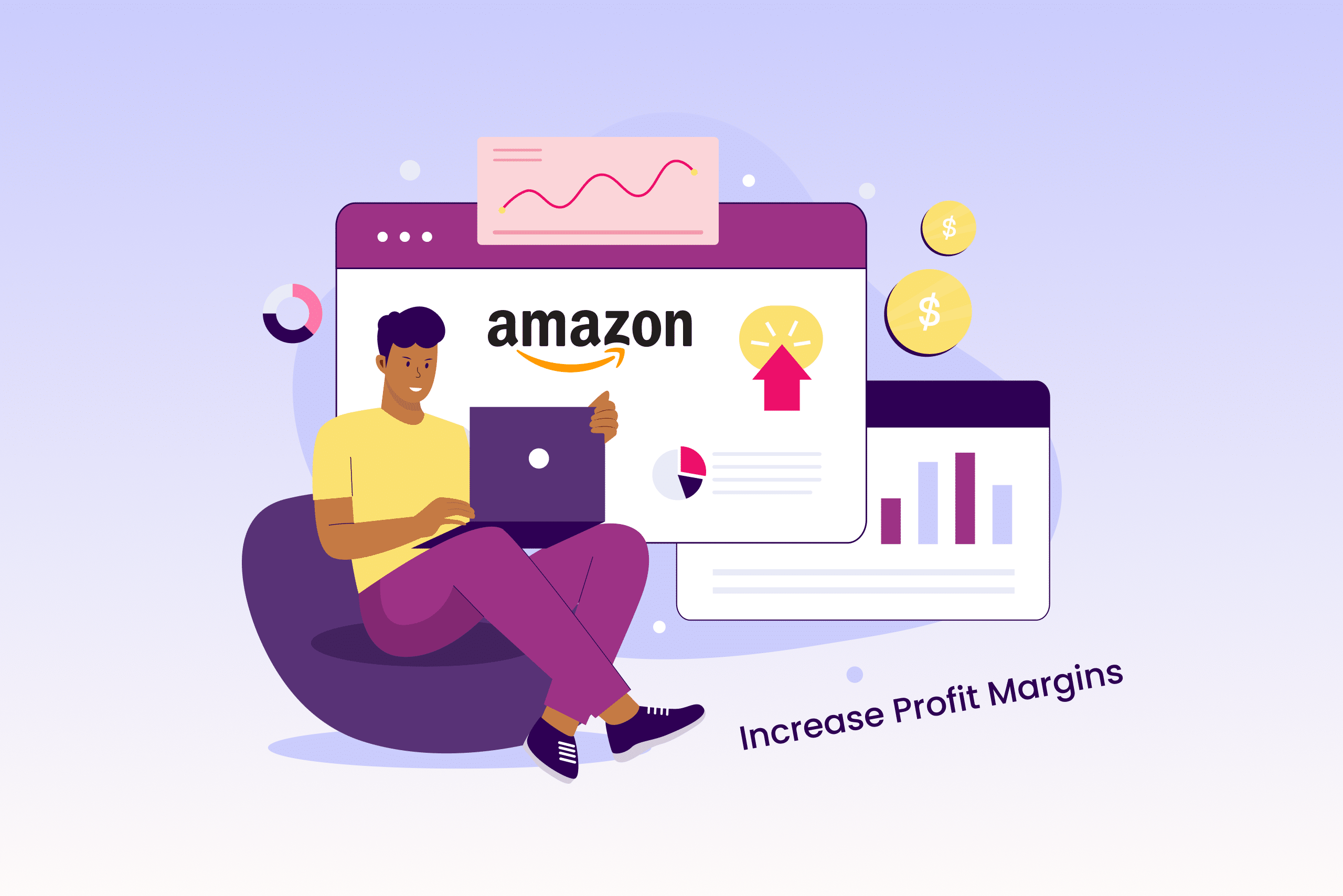One key sign of success as an Amazon seller is having a profitable business. This can be challenging due to the various expenses that you have to keep your enterprise running, from inventory to paid advertising. Despite these hurdles, consistently making a profit can help boost your confidence in your online business and allow you to grow your company while staying within your means.
To help your business reach its full potential, it’s important to take steps to increase your profit margins. Your profit margin refers to the amount of money you’re making on your products after deducting all of the costs involved. This figure, which is expressed as a percentage, represents the portion of your total revenue that you take home as a profit after subtracting all relevant expenses.
In this guide, we’ll help you increase your Amazon profit margins for greater long-term success. Here’s what you need to know about maximizing your profits as an eCommerce seller.
How is Amazon Profit Margin Calculated?
As an Amazon seller, there are two types of profit margins you should be familiar with: your gross profit margin and your net profit margin.
Gross Profit Margin
Your gross profit margin helps illustrate the profitability of your products. As a direct indicator of how well your goods are selling, this is a crucial figure to understand as an online seller.
To calculate your gross profit margin, take your total sales revenue and subtract your cost of goods sold (COGS). Divide the result by your total sales revenue and express it as a percentage.
Gross Profit Margin = (Total Sales Revenue – COGS) / Total Sales Revenue
Here’s an example to help illustrate: Say you made a total of $1,000 from product sales, and your COGS is $400. You would calculate your gross profit margin like this:
(1,000 – 400) / 1,000 = 0.6 (60%)
Net Profit Margin
Unlike your gross profit margin, your net profit margin accounts for all of the costs involved in running your business. For this reason, it’s common to have a lower net profit than gross profit, especially if you have a lot of overhead costs associated with your business.
To calculate your net profit margin, subtract all of your business costs from your total sales revenue. These costs include COGS, taxes, and Amazon’s fees. Then, divide the result by your total sales revenue and convert the resulting figure into a percentage.
Net Profit Margin = (Total Sales Revenue – ALL Costs) / Total Sales Revenue
Say you made $1,000 from product sales, but your total business costs amount to $800. You would calculate your net profit margin like this:
(1,000 – 800) / 1,000 = 0.2 (20%)
Profit Margin is Crucial for Amazon Businesses
To gauge how your Amazon business is performing, it’s crucial to take your gross and net profit margins into consideration. Both of these figures offer valuable insight into your business’s profitability and overall financial performance. Once you’ve calculated the two profit margins, take the time to compare both percentages. This will help shed light on the reality of your business expenses and revenue.
You can also use profit margins to determine what you need to change about your business strategy in the future. For example, if your advertising costs are hurting your pocket and seeing minimal ROI, you might want to reallocate that budget to help your bottom line. By analyzing your margins, you can identify specific issues with your strategy and make the right changes to it.
What’s a Good Profit Margin for Amazon Sellers?
Now that you have a better understanding of how profit margins work, you’re probably wondering what a good margin is for Amazon sellers. The answer depends on a number of factors, including your product category, your cost of goods, and your pricing strategy.
Most Amazon sellers fall into a profit margin of 15-20% based on Shopify estimates and NYU Stern. This is considered sustainable for businesses. As a rule of thumb, any profit margin above 20% is considered excellent, while anything below 5% is typically unsustainable.
As we discussed earlier, it’s normal for your net profit margin to be slightly lower than your gross profit margin. However, to stay on the safe side, do what you can to keep both percentages within the 15-20% range.
How to Increase Amazon Profit Margins
There are a number of strategies you can use to increase your profit margins on Amazon. It’s important to remember that boosting your margins is a process of trial and error. To figure out what works and what doesn’t, examine important metrics and don’t be afraid to experiment with ways to improve them. With enough practice and testing, you can build a solid strategy for increasing your profits.
Track Sales Data
Understanding and analyzing your sales patterns can enable you to make smarter marketing decisions. Your sales data provides a lot of useful insight, such as which products sell the best, who your target customer is, and which pricing model is most effective. Pay close attention to product performance to see which items are garnering the most sales. Remember to check this information regularly to ensure that you’re utilizing the most up-to-date data.
Another crucial aspect of your sales data is ad performance. It’s important to evaluate overall ad performance to see if you have a strong return on ad spend. Track your ads to see what graphics and copy lead to the most clicks and sales.
When planning your ads, we recommend that you use dayparting. Dayparting is an advertising strategy in which you schedule different ads for certain times of the day to maximize your reach. Research when each of your ads is most likely to convert and schedule them accordingly. This way, you’ll be reaching your target audience for each product at the optimal time of day.
Decrease Cost of Goods Sold (COGS)
Often, your cost of goods sold (COGS) takes up a significant portion of your business expenses; minimizing it can help raise your profit margins substantially. A wide range of expenses can be included in your total COGS. To reduce your expenses altogether, it helps to break down your individual costs and manage them one by one.
One key cost to account for is supplier costs. These can include various types of expenses, including:
- Labor costs
- Shipping costs
- Raw materials
If you find that your supplier costs eat up a large portion of your business expenses, consider requesting a discount or consolidating vendors.
Bulk ordering can also help reduce your total COGS. Since products packaged in bulk require less distribution, your manufacturer’s distribution costs will be lower. Moreover, packaging and distributing your products in bulk saves a lot of time that you can dedicate to other areas of your business.
Adjust Pricing
Unsurprisingly, your pricing model has a direct impact on your Amazon profit margins. It’s crucial to experiment with product pricing to determine which price point is most attractive to your customers. Above all, ensure that you’re always working to increase the value of your products. Offering a high-quality, in-demand product justifies selling it at a higher price, which can help boost your margins.
We recommend using dynamic pricing as your pricing strategy. This is a pricing model in which you adjust the price of your products based on external factors, such as market demand, price bounding, and changes in supply. Adopting this strategy allows you to stay on top of current trends and respond to them appropriately, keeping you in line with consumer expectations.
Decrease Customer Acquisition Cost (CAC)
The average amount of money you spend to acquire a new customer should also be factored into your business expenses. As you become more skilled at marketing, you’ll be able to attract more shoppers to your brand while spending less money. The goal is to constantly test out new strategies to figure out what works best for you.
Run Engaging Ads
One of the most effective marketing strategies is running ads. Ads are a highly dynamic promotional tool. The copy, graphics, and links you use should constantly be shifting in response to current trends. When designing ads for your brand, don’t hesitate to test out multiple types of advertisements. It’s also important to calculate the cost of advertising on Amazon so that you stay within your budget.
Increase Conversion Percentage
The most direct way to reduce your customer acquisition cost is to increase your conversion percentage. As your conversion rate goes up, your average acquisition cost tends to go down. A key strategy for boosting your conversion rate is producing direct response copywriting. This is copy written with the intention of sparking an immediate response from your customer, which can help boost sales.
Increase Average Order Value (AOV)
In a highly competitive environment, you need to solve your customer’s problem better than everyone else. It’s crucial to offer a high-quality, innovative product and stellar customer service to accomplish this. In addition, be sure to collect positive Amazon reviews as compelling social proof.
If customers perceive your product to have a lot of value, they’ll be willing to spend more money on it. There are various methods you can use to increase your average order value on Amazon.
- One popular strategy is offering add-ons. Add-ons are inexpensive, lightweight products that Amazon ships with orders over $25.
- You can also experiment with product bundles to boost your average order value. Product bundling is the process of grouping two or more complimentary items and listing them together.
Increase Customer Lifetime Value (LTV)
Customer lifetime value is a metric used to predict the total revenue that you can expect to receive from a single customer. By forecasting the average amount of money your customers will spend on your products, you can get a better idea of what your bottom line will be. It’s important to be proactive about increasing customer lifetime value so that you’re always boosting your profit margins.
One strategy for increasing customer lifetime value is maximizing purchase frequency. To encourage existing buyers to continue purchasing from you, establish loyalty programs, experiment with retargeting ads, keep in touch via a newsletter, and offer complimentary products, also known as cross-selling. Overall, staying present in customers’ minds helps increase your chances of making additional sales.
Stay on Top of Your Amazon Profit Margins
Calculating your profit margins can help you gauge your performance as an Amazon seller. There’s always room for improvement, whether you’re trying to lower your customer acquisition costs or adjusting your product pricing strategy. At Trellis, we’re here to assist you with various aspects of selling on Amazon’s marketplace. From building a dynamic pricing model to generating SEO-rich content, it’s our goal to help bring your eCommerce goals within reach.



